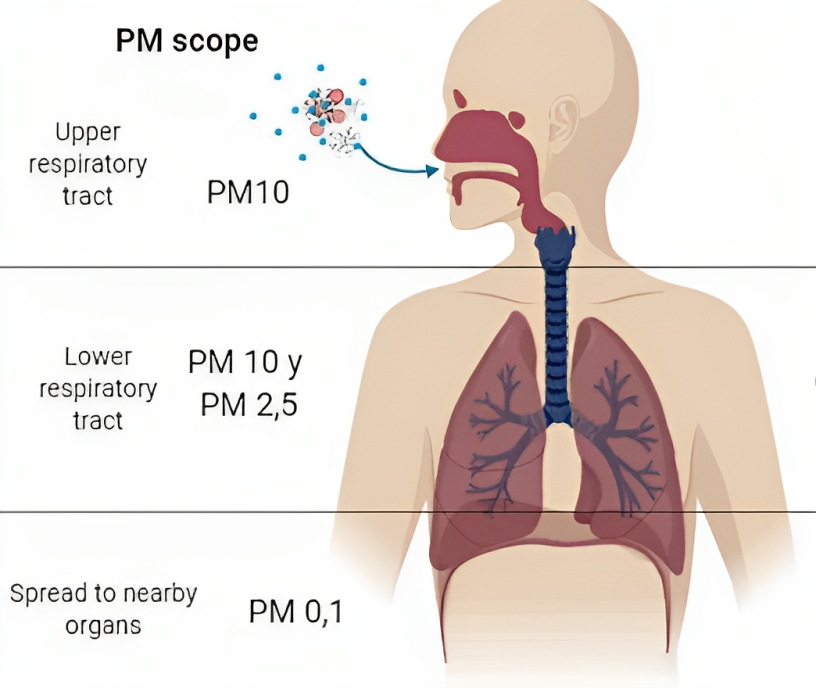1.2. Adverse health effects
Here, we present a brief overview of the health effects of the three most relevant air pollutants. The severity of the effects depends on both the person's health status and the duration and frequency of exposure to high concentrations.
- Particulate matter (PM10, PM2.5, PM1, PM0.1):
The particle size directly affects its potential for causing health problems (see Figure 1.2). Coarse particles (diameter less than or equal to 10 µm) will only reach the superior airway cavity. The smaller the diameter the more severe the effects, as small particles can penetrate deep into the lungs (e.g., particles with diameter less than 1 µm) and may even reach the bloodstream (particles with diameter less than 100 nm). Numerous scientific studies have linked particle pollution exposure to a variety of health problems, including:
- Increased respiratory symptoms, such as irritation of the airways, coughing or difficulty breathing.
- Aggravated asthma and decreased lung function.
- Non-fatal heart attacks, irregular heartbeat.
- Premature death of people with heart or lung disease.
Figure 1.2: Main effects and anatomical reach of particulate matter. Depending on the aerodynamic diameter (< 0.1 µm, 2.5 µm, or 10 µm), particulate matter has the capacity to enter different anatomical sites of the respiratory tract, where it can remain or spread to other organs and tissues, causing diverse effects on them, and increasing susceptibility to human pathologies. (Loaiza-Ceballos et al., 2022).
- Nitrogen dioxide: breathing in air with a high concentration of this pollutant can irritate airways in the human respiratory system:
- Short exposures can aggravate respiratory diseases, particularly asthma, leading to respiratory symptoms (such as coughing, wheezing, or difficulty breathing), hospital admissions, and visits to emergency rooms.
- Longer exposures may contribute to the development of asthma and potentially increase susceptibility to respiratory infections.
-
Ozone: exposure to ozone can produce the following effects, depending on the level of exposure:
- Coughing and sore or scratchy throat.
- Difficulty in breathing deeply and vigorously, and pain when taking a deep breath.
- Inflammation of and damage to the airways.
- Increased susceptibility of the lungs to infection.
- Aggravation of lung diseases such as asthma, emphysema, and chronic bronchitis; increased frequency of asthma attacks.
- Eye irritation, tearing (watery eyes), headaches.
In central to northern Europe, Saharan dust rarely affects the air quality at breathing height; only after it has rained out can resuspended dust reach the breathing height. However, during certain Sahara dust events, high concentrations can occur at breathing height in Spain and Portugal, contributing to poor air quality. In the south of Spain, the Saharan dust can even contribute up to 40% of the PM (Nicolas et al., 2008).
